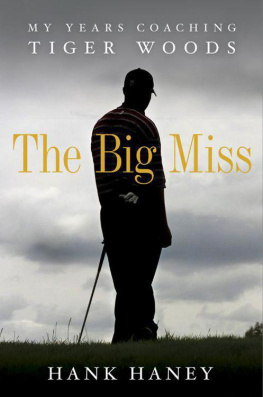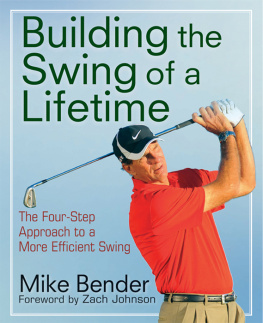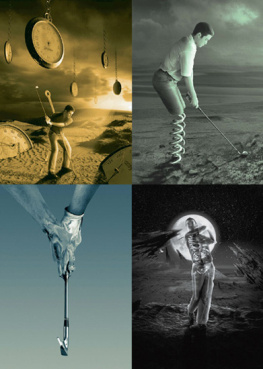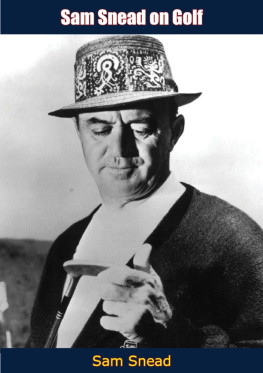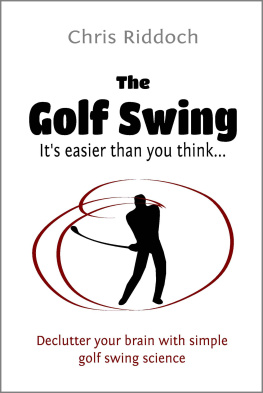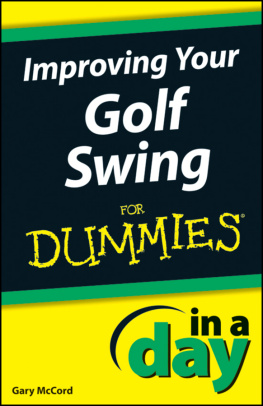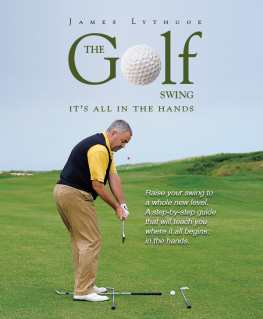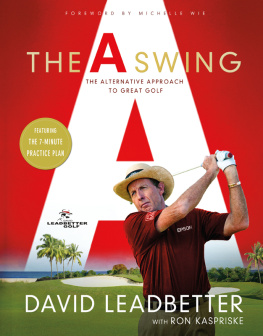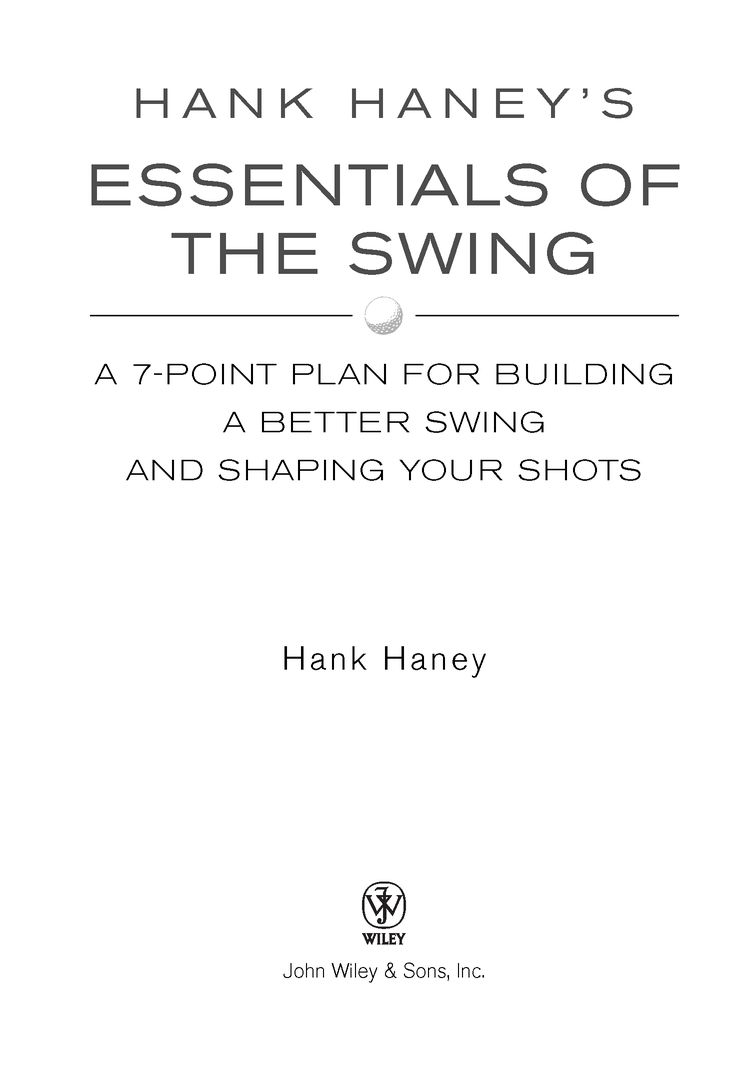Table of Contents
FOREWORD
May I tell you something? Hank Haney asked. Hes been watching me play golf for twenty years, exercising singular restraint in never once fixing what is so clearly a flawed action. Sam Snead once said my grip resembled a can of worms. The writer Charles Price once said that if I hit the ball any lower Id be playing underground. The comedian Ray Romano once observed that my putter resembles a metal detector. But through all of these years, Hank suffered in silence.
He couldnt take it anymore on the 13th fairway at Pine Valley Golf Club, where we get together every spring for a couple of days of nonstop golf. On this occasion the catalyst was a weakly struck 3-wood that found the sandy hazard short and left of the green.
Let me show you something, he said. You play a shot by walking up to the ball and taking your stance and looking down at the target. For as long as golfs been played, no good golfer ever started from beside the ball. Golf starts by standing behind the ball and looking at the target. Then you walk to the side of that line and take your address position.
I guess he had a point. Why should I think Id be the first good golfer in five hundred years to start my setup from beside the target line? Theres a good chance that the coach of Tiger Woods may know something about how to set up to the ball, so I nodded knowingly and filed his advice away for future application. Since that revelation, I cant say its exactly transformed everything. My trajectory is still practically underground, but sighting the target from behind the ball has given me more consistency. It has the secondary effect of improving my posture. And it forces me to slow down, which has always been a mental fault.
When I reported to Hank months later that his impromptu lesson made an impression on me, he said: You could make an argument that everybodys swing mistakes come from setup mistakes. That doesnt mean they are all going to go away if you set up well, but the whole evolution of your swing might have started just from setting up poorly. I try to make my teaching as simple as I can. All Im trying to do is help you take a little step. And then if you can take a little step, then you take another one. I dont want to make it more complicated by advocating giant leaps. Just be patient with a little step. If you take enough little steps, you are going to cover a tremendous amount of ground.
The hard part as a teacher, though, isnt necessarily looking at somebody and seeing what they need to do, but its the convincing part. In your case, what struck home was my statement about five hundred years, as long as golfs been played, nobody has ever started from the side and played well. So that was the convincing part that got you to commit. It was the most important part of the message for starters, because if it didnt come with that, it wouldnt have clicked.
So whats the next step? I asked.
What are you looking at when you now start the swing from behind the ball? replied Hank. Pick an intermediate targeta leaf, a sprig of grass, a spot on the groundand set your aim to that point. You know, Nicklaus and Tiger both pick that intermediate target right out in front of them. In effect, bringing the target closer. And, my gosh, its just amazing that those two guys do something that simple and yet everybody else who plays golf doesnt do it. You know, I mean, what else do you need? People want to make the game harder than it is. My teaching is about making it simple.
Over many hours of discussion through the years, Hank has convinced me that there are two legitimate ways of teaching. The first is a quick fix. In golf, the master of the quick fix is the British genius John Jacobs, whos considered the godfather of the European Tour and is one of Hanks original mentors. Jacobs could stand with his back to the student, observing only the flight of the ball, and magically offer the key setup changes necessary for improvement. Basically when you do that, youre picking which bad impact youre going to live with, says Haney. In other words, you might make somebody whose swing is too steep swing more shallow. Now they are on their way to being too shallow, but thats a lot better than being too steep. Sometimes Jacobs strengthens the griprotates the hands clockwise on the cluband once again fixes the problem by turning a slice into a hook.
Youve got to have some element of that in your teaching, or youre never going to be successful, because its what everybody wants. Even students who say they dont want it, want it, because everyones determination and persistence and dedication to a swing change is going to be tested at some point. You can line up somebody with a good grip and all the fundamentals, but if theyre hitting grounders trying to make the change, how long will they stick with it?
Haney believes the other method is to teach swing shape. The theory is, if you create a great-looking swing, youll get a great-looking shot. Every teacher I know, regardless of what they say about teaching the student, not the swing, actually teaches a swing based on a model, says Haney. Even the biggest proponent of I work with what youve got and I dont change it all around still has some vision of what the swing should look like.
Hanks first two books were constructed around the first way to teachfixing swing problemsand they really offered insight into the way he gives a lesson. If youve read those books, and for those who havent I recommend you do, you would walk away having a pretty good idea of what taking a lesson from Hank would be like. In this book, Haney and his talented collaborator, Golf Digests European correspondent John Huggan, explain Hanks vision of what every aspect of the swing should look like. Hes focused more on everything you would do, piece by piece, to build the best swing that you could for you. Theres no short game, no puttingjust full swing. Hank Haneys Essentials of the Swing is a culmination of thirty years of teaching. Its the model on which Hank bases his philosophy of the game. Its everything he now pours into the young students at the Hank Haney International Junior Golf Academy, and its everything hes imparted to Tiger Woods over their five years of work together.
Tigers thirst to improve is greater than anybody Ive ever seen, says Haney. Even though hes achieved so much, its not something he ever talks about, or thinks about, or dwells on. Everybody talks about what Tiger wants to dolike he wants to beat Nicklauss record, win the most majors, set records. I love when I hear everybody say that, because in all the time that I have spent around Tiger Ive never heard him, one time, say anything like that. The only goal Ive ever heard him talk about is, he wants to get better. And I know the way he thinks. He thinks, If I get better, everything will take care of itselfall those other things will just be a foregone conclusion. So yes, hes achieved so much, but he doesnt act like he has. He just acts like its all ahead of him, and what excites him is the opportunity to improve.
When Tiger took his hiatus from the game in 2008, he called Haney on his cell phone the day before his knee surgery with one question: Whats the plan going to be for when I get back?
But youre not going to be back for eight months, replied Hank.
Yeah, but I want to be thinking about what we need to work on.
As an observer of both Tiger and Hank, I sense its this quality that binds them together and provides the challenge for both to keep going.


